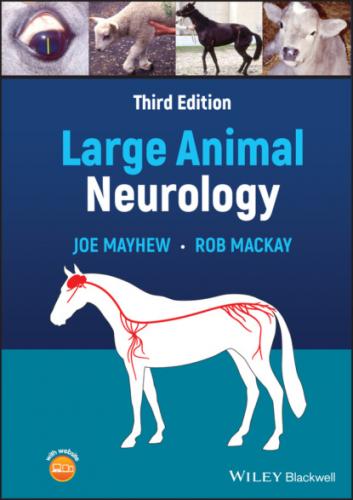If all else fails, examine the patient again!
Table 2.2 Outline of basic format for the neurologic examination, based on that for the horse
| Region | Evaluation | Sites evaluated | Points to emphasize | |
|---|---|---|---|---|
| Adult | Neonate <2 weeks | |||
| Head | Behavior | Forebrain | History and owner’s understanding Seizures, especially mild and focal. VIDEO Subtle asymmetry in menace and nasal sensation | Quick adjustment ~2–7 days Paralytic state with cradling Partial seizures—just face, jaw |
| Mentation/sensorium | Forebrain Midbrain | Response to environment Sleep attacks more common than epilepsy Cardiovascular syncope very rare | Adjustment ~24 h | |
| Head posture and movement | Neck Forebrain—head and neck turn Vestibular—head tilt Tremor—check eyeballs | Stiff/twisted neck Head tilt (VIII) verses head turn (forebrain) Head tremor—cerebellar Head/neck ataxia—cerebellar/spinal Head shaking—trigeminal | Flexed head posture and ataxic movements normal | |
| Cranial innervation | CN II – XII Brainstem Cervical sympathetic supply | Evaluate regions of head Fundic examination Repeat test for subtle asymmetries Reevaluate when totally relaxed | Menace deficit <7 days Eye rotation dorsomedial | |
| Body | Neck and forelimbs | C1–T2 | Particularly asymmetry Only flexor reflex useful Hopping | All reflexes Hyperreflexia normal Crossed extension normal |
| Trunk and hindlimbs | T3–S2 L4—femoral n. L5—cranial gluteal n. L6–S1—sciatic n. | Particularly asymmetry Patellar reflexes usefulFlexor reflex useful | All reflexes Hyperreflexia Crossed extensor reflex Extensor thrust response | |
| Tail | Ca1+ | Extension and flexion | ||
| Perineum, anus, rectum, and bladder | S1–5 | S1–2 is common fracture site | ||
| Gait and posture | ORTHOPEDIC PROBLEMS! | Neuromusculoskeletal | VIDEO! Shoulder and hip atrophy common Possible analgesic trial | SEPSIS! |
| Positional CP deficits | Brainstem, spinal cord, and sensory nerves | Manual placement of feet/limbs noncontributory | Prematurity | |
| Extensor weakness | Brainstem, spinal cord, and PNS | Especially final motor neuron lesion | Extensor strength dominant | |
| Flexor weakness | Brainstem, spinal cord, and PNS | |||
| Ataxia | Spinal ataxia | Irregular position and placement | ||
| Cerebellar ataxia | Hypermetria characteristic; F > H | Normal to degree | ||
| Vestibular gait | Crouched posture Deliberate (predictable) stepping Wide‐based, staggering gait | Normal to degree |
CP, conscious proprioception; CN, cranial nerve.
Head
For the routine large animal patient examination, evaluate what one can from a distance, preferably before the patient is disturbed, for the first observations of behavior, mentation and head, neck, trunk, and limbs. Head and neck deviations need to be assessed closely by straightening the neck along the midline to determine what neck and head asymmetry may be present. Allow the patient to smell an (often peppermint‐tainted) hand for introduction and observe the face, particularly eyes and associated structures, for an expressional response. Then, examine the parts of the head and neck for the evaluation of cranial nerve function (Table 2.3).
Table 2.3 Assessment of cranial nerve function
| Cranial nerve | Major function | Normal reflex/response/assessment | ||
|---|---|---|---|---|
| I | Olfactory | Sense of smell | Challenging—most odors also stimulate CNV | |
| II | Optic | Afferent pathway for vision and light | Menace response. Pupillary light reflex. Swinging light test Dazzle response | |
| III | Oculomotor | Pupillary constriction Upper eyelid levator muscle Extraocular muscles | Pupillary light reflex Induced eyeball movement Medial movement of globe Ptosis rarely apparent | |
| IV | Trochlear | Extraocular muscle (dorsal oblique) | Ventrolateral rotation of globe | |
| V | Trigeminal Sensory | Sensory to head, face, and tongue | Ear, eyelid, and lip (facial) reflexes Pain perception: head, nasal septum, and rostral tongue | |
| Motor | Motor to muscles of mastication | Chewing, jaw tone, and muscle mass (temporalis, masseter, and pterygoid) | ||
| VI | Abducens |
Extraocular muscle (retractor oculi) Extraocular muscle (lateral
| ||
